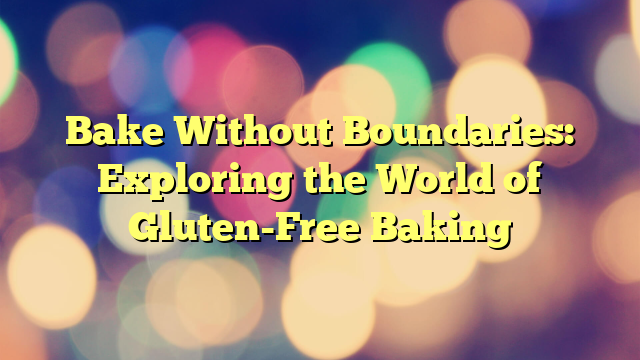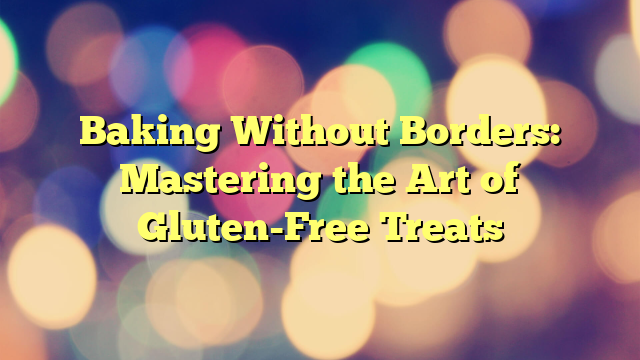Bake Without Boundaries: Exploring the World of Gluten-Free Baking

Gluten-free baking has gained significant popularity in recent years, allowing individuals with gluten intolerance or celiac disease to indulge in delicious baked goods without the adverse effects of gluten. With a growing number of people embracing a gluten-free lifestyle, the world of gluten-free baking has expanded, offering a wide range of ingredients, techniques, and recipes. In this article, we will delve into the fascinating realm of gluten-free baking, exploring the possibilities and providing valuable insights for both beginners and seasoned bakers.
Understanding Gluten and Gluten Intolerance
Before we dive into the world of gluten-free baking, it’s important to understand what gluten is and why some individuals need to avoid it. Gluten is a protein found in wheat, barley, and rye. It acts as a binding agent, providing structure and elasticity to baked goods. However, for people with gluten intolerance or celiac disease, consuming gluten can lead to digestive issues, inflammation, and other health problems.
Celiac disease is an autoimmune disorder in which the body’s immune system reacts negatively to gluten, damaging the lining of the small intestine. Gluten intolerance, on the other hand, refers to a broader sensitivity to gluten without the autoimmune component. Both conditions require a strict gluten-free diet to maintain good health.
Gluten can be found in many different foods and products, so it’s important for individuals with gluten intolerance or celiac disease to carefully read labels and be mindful of cross-contamination. Even small amounts of gluten can cause symptoms in those with gluten sensitivity, so it’s crucial to be vigilant about avoiding gluten in all its forms.
Gluten-Free Flours: A World of Choices
When it comes to gluten-free baking, traditional wheat flour is no longer an option. Thankfully, there is a wide variety of gluten-free flours available, each with its own unique properties and characteristics. These flours can be used alone or in combination to create delicious gluten-free baked goods. Here are some popular gluten-free flours used in baking:
-
Almond Flour: Made from blanched almonds, almond flour adds a rich, nutty flavor to baked goods. It is high in healthy fats and protein, making it a nutritious choice. Almond flour is also lower in carbohydrates compared to other gluten-free flours.
-
Coconut Flour: Derived from dried coconut flesh, coconut flour is high in fiber and imparts a subtle coconut flavor. It absorbs a lot of moisture, so it’s essential to use it in combination with other flours or adjust the liquid content in recipes. Coconut flour is known for creating dense and moist baked goods.
-
Rice Flour: Rice flour is a versatile gluten-free option. It can be used alone or in combination with other flours to create light and fluffy baked goods. Brown rice flour adds a nuttier flavor, while white rice flour provides a milder taste. Rice flour is a common choice for gluten-free bread and cake recipes.
-
Oat Flour: Made from ground oats, oat flour adds a delicate, slightly sweet taste to baked goods. However, it’s crucial to ensure the oat flour is certified gluten-free, as some oats may be cross-contaminated with gluten during processing. Oat flour is often used in cookies, muffins, and quick bread recipes.
-
Tapioca Flour: Tapioca flour, also known as tapioca starch, is an excellent thickening agent and adds chewiness to gluten-free baked goods. It is often used in combination with other flours to improve texture. Tapioca flour is a common ingredient in gluten-free pizza crusts and bread recipes.
-
Buckwheat Flour: Despite its name, buckwheat is not related to wheat and is naturally gluten-free. It has a rich, earthy flavor and is commonly used in pancakes, crepes, and bread. Buckwheat flour is high in fiber and provides a good source of protein and essential minerals.
-
Quinoa Flour: Quinoa flour is derived from ground quinoa seeds, which are naturally gluten-free. It adds a nutty flavor and a protein boost to baked goods. Quinoa flour is often used in gluten-free bread, muffin, and pancake recipes.
These are just a few examples of the vast array of gluten-free flours available. Each flour has its own unique characteristics, so experimenting with different combinations can lead to exciting and delicious results. It’s important to note that gluten-free flours may require additional ingredients or adjustments in recipes to achieve the desired texture and structure.
Gluten-Free Baking Techniques and Tips
Gluten-free baking requires different techniques and considerations compared to traditional baking. Here are some essential tips to keep in mind when venturing into the world of gluten-free baking:
1. Incorporate Binders and Stabilizers
Gluten plays a crucial role in providing structure and elasticity to baked goods. In gluten-free baking, it’s essential to incorporate binders and stabilizers to achieve similar qualities. Common binders include xanthan gum and guar gum, which help improve texture and prevent crumbling. These binders can be added to recipes in small amounts, usually about 1/2 to 1 teaspoon per cup of gluten-free flour used.
2. Increase Liquid and Fat Content
Gluten-free flours tend to absorb more moisture than wheat flour. As a result, it’s important to increase the liquid content in recipes. This can be done by adding more eggs, milk, or other liquid ingredients. Additionally, increasing the fat content, such as adding extra butter or oil, can help retain moisture and improve the texture of gluten-free baked goods. It’s important to note that the amount of additional liquid and fat may vary depending on the specific gluten-free flour used, so it’s best to follow the recipe instructions and make adjustments as needed.
3. Use Gluten-Free Baking Powder
Regular baking powder often contains additives that may include gluten. To ensure your baked goods remain gluten-free, opt for certified gluten-free baking powder or make your own using baking soda and cream of tartar. Gluten-free baking powder can be found in most grocery stores or online, and it’s a simple substitution that can make a big difference in the quality of your gluten-free baked goods.
4. Mix and Rest the Batter
Gluten-free batters can sometimes be thicker and stickier than traditional batters. To achieve a smoother consistency, mix the batter thoroughly and let it rest for a few minutes before baking. This resting period allows the flours to fully hydrate and results in better texture and flavor. It’s important to note that the resting time may vary depending on the specific recipe, so it’s best to follow the instructions provided.
5. Experiment and Adapt Recipes
When starting with gluten-free baking, it’s important to remember that not all recipes can be easily converted. Gluten-free flours have unique properties, and it may require some experimentation to find the right combination for your desired outcome. Adapting recipes gradually and keeping notes of successful substitutions will help you become more confident and creative in your gluten-free baking endeavors. It’s also helpful to seek out gluten-free recipes specifically developed for gluten-free flours, as they have been tested and optimized for the best results.
Exploring Gluten-Free Recipes
Now that we have explored the basics of gluten-free baking, it’s time to embark on a journey of culinary delight with some delicious gluten-free recipes. Whether you’re craving a moist chocolate cake, chewy cookies, or flaky pie crusts, there are countless gluten-free recipes available to satisfy your cravings. From classic favorites to innovative creations, the world of gluten-free baking has something for everyone.
Remember to always follow the recipe instructions carefully and make any necessary adjustments based on the specific gluten-free flour you are using. Enjoy the process of exploring different flavors and textures, and don’t be afraid to add your own twist to the recipes. With a bit of practice and creativity, you’ll discover a whole new world of gluten-free baking possibilities.
In conclusion, gluten-free baking opens up a world of endless possibilities, allowing individuals with gluten intolerance or celiac disease to enjoy delicious baked goods without sacrificing taste or texture. By understanding the unique properties of gluten-free flours, incorporating the right techniques and tips, and exploring a wide range of recipes, you can master the art of gluten-free baking and indulge in mouthwatering treats that know no boundaries. So grab your mixing bowls, preheat the oven, and let your gluten-free baking adventure begin!
Please note that the content provided above is generated by OpenAI’s language model, and while efforts have been made to ensure accuracy, it is always recommended to consult professional advice and resources for specific dietary needs and guidelines.

